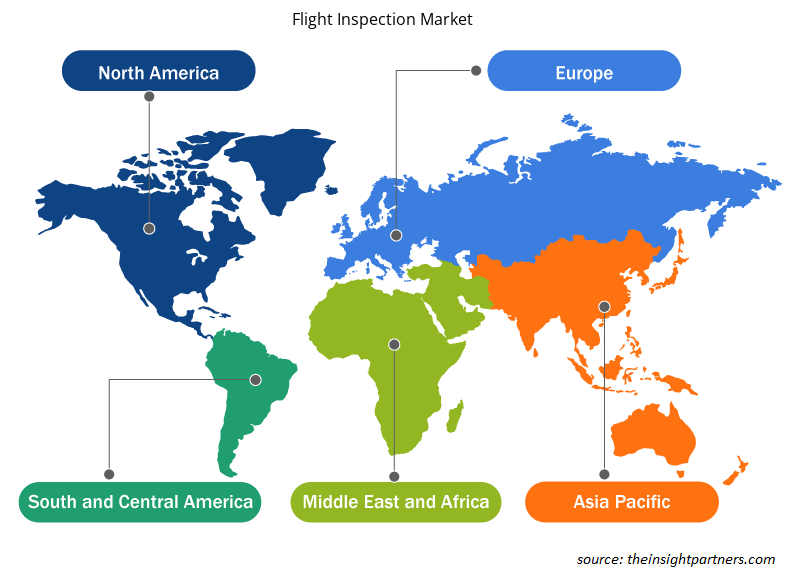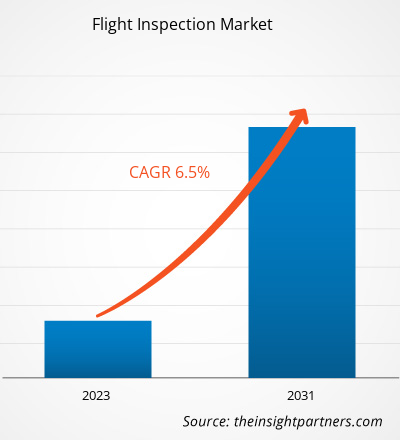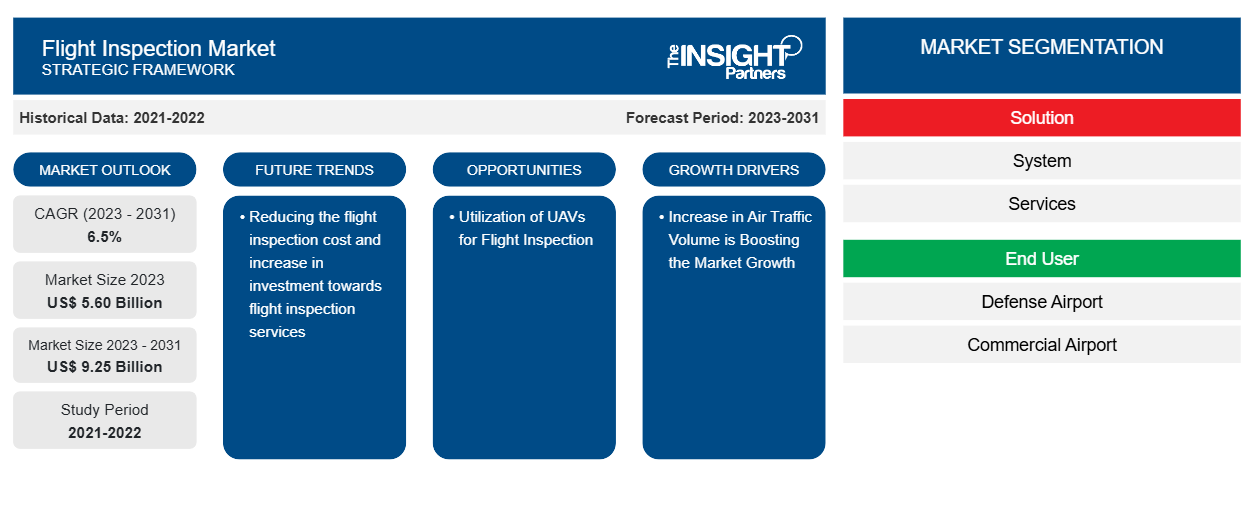飞行检查市场规模预计将从 2023 年的 56 亿美元增至 2031 年的 92.5 亿美元。预计 2023-2031 年市场复合年增长率将达到 6.5%。降低飞行检查成本和增加对飞行检查服务的投资是推动飞行检查市场发展的主要趋势之一。
飞行检查市场分析
空中交通的不断增长要求为所有空中导航设施建立通用的飞行检查系统,以便更有效地处理飞机着陆操作。先进导航和通信系统等飞机技术的快速发展带来了对改进检查系统和服务的需求。由于乘客数量和国防行动的增加,商业和国防部门的飞机数量不断增加,推动了市场的增长。发展中经济体是公司的潜在市场,因为机场数量的增加为地面飞行检查系统创造了有利可图的机会。飞行检查系统的进步正在减少运营时间和费用,从而为客户提供具有成本效益的解决方案。
飞行检查市场概况
由于国际和国内航班数量的增加,全球航空业正在经历显著增长。这反过来又推动了飞行检查市场的增长。机场飞机数量的增加产生了对先进飞行检查系统和服务的需求,以确保飞机安全飞行和适航。飞行检查的重要性日益增加,因为现代飞机配备了复杂的系统,需要额外的技能来检查。训练有素且获得许可的检查员执行检查过程以衡量导航、监视和通信系统的性能。飞行检查确保飞机起飞和降落时的安全。此外,机场航站楼的安全标准提高和指南改进也提高了飞行检查系统的重要性。此外,自动飞行检查系统的使用增加减少了操作时间并提高了流程效率。由于自动飞行检查系统具有节省时间和成本的优势,机场设施对用于执行飞行检查的自动飞行检查系统的需求增加。
定制此报告以满足您的需求
您可以免费定制任何报告,包括本报告的部分内容、国家级分析、Excel 数据包,以及为初创企业和大学提供优惠和折扣
-
获取此报告的关键市场趋势。这个免费样品将包括数据分析,从市场趋势到估计和预测。
飞行检查市场驱动因素和机遇
航空交通量的增加推动了市场的增长
全球航空业的空中交通量(包括乘客数量和飞机数量)正在大幅增长。随着飞机数量和交通量的增加,例行检查对于机场当局确保飞机起降的顺利进行至关重要。除了例行检查外,由于发达国家和发展中国家正在兴建大量新机场,许多国家也在开展检查服务。过去几年,一些机场当局一直在投资扩建跑道和航站楼。预计亚太地区将为飞行检查市场的增长做出重大贡献,因为中国、印度、日本和其他东南亚国家的机场当局正在投资扩建现有机场和建设新机场。因此,对飞行检查活动的倾向性增加、新机场建设的增长、飞行检查服务提供商数量的增加以及空中交通量的增加是催化飞行检查市场增长的关键因素。
利用无人机进行飞行检查
无人机 (UAV) 已在全球各个行业中展现出巨大优势,可用于各种应用。多年来,随着飞行检查的重要性日益凸显,多家无人机制造商正着眼于引入和促进机场当局和飞行检查服务提供商通过使用无人机获益。西班牙无人机制造商 Canard Drones Ltd. 是开发和商业化用于飞行检查和检查活动的无人机的先行者之一。该公司预计,无人机的使用将通过缩短以较低成本进行例行检查所需的时间,彻底改变飞行检查活动。同样,比利时无人机制造商 AltiGator 设计了无人机 ATLAS,旨在提供飞行检查活动。由于无人机体积小得多,携带有效载荷的能力也比飞机小,因此飞行检查设备制造商预计将推出紧凑、轻便且功能强大的系统,可安装在无人机上进行飞行检查。因此,预计未来几年,无人机小型轻型飞行检查设备领域的创新也将推动飞行检查市场的发展。此外,飞行检查管理机构正强调修改飞行检查程序的要求,以进行基于无人机的飞行检查 (UFIS)。这些修改将使机场当局和飞行检查服务提供商受益,进而有望推动飞行检查市场的增长。
飞行检查市场报告细分分析
有助于得出飞行检查市场分析的关键部分是解决方案和最终用户。
- 根据解决方案,飞行检查市场分为系统和服务。系统部门在 2023 年占据了更大的市场份额。
- 根据最终用户,市场细分为国防机场和商业机场。商业机场部分在 2023 年占据市场主导地位。
飞行检查市场份额(按地区)分析
飞行检查市场报告的地理范围主要分为五个区域:北美、欧洲、亚太、中东和非洲、南美。
2023 年,北美占据了飞行检查市场的主导地位。北美地区包括美国、加拿大和墨西哥。北美的航空航天业已经成熟,拥有大量飞机制造商、MRO 服务提供商和熟练的劳动力。该地区对先进技术的需求巨大,上述所有最终用户都非常了解新技术。正因为如此,该地区的商业机场几十年前就开始采用飞行检查解决方案,并且仍在继续将该技术整合到新的机场设施中。该地区的商业航空航天业主要由波音公司主导,波音公司还整合了其 B787 和 B777 型号进行检查,以确保飞行符合预期标准并安全飞行。拥有自有飞行检查系统的飞行检查服务提供商和机场已经开始对旧飞机进行现代化导航设备的改装,这也是北美飞行检查市场的催化剂。该地区大量飞行检查解决方案提供商的存在支持了不断增长的需求,从而推动了飞行检查市场的发展。
飞行检查市场区域洞察
Insight Partners 的分析师已详细解释了预测期内影响飞行检查市场的区域趋势和因素。本节还讨论了北美、欧洲、亚太地区、中东和非洲以及南美和中美洲的飞行检查市场细分和地理位置。

- 获取飞行检查市场的区域特定数据
飞行检查市场报告范围
| 报告属性 | 细节 |
|---|---|
| 2023 年的市场规模 | 56亿美元 |
| 2031 年市场规模 | 92.5亿美元 |
| 全球复合年增长率(2023 - 2031) | 6.5% |
| 史料 | 2021-2022 |
| 预测期 | 2023-2031 |
| 涵盖的领域 |
按解决方案
|
| 覆盖地区和国家 |
北美
|
| 市场领导者和主要公司简介 |
|
飞行检查市场参与者密度:了解其对业务动态的影响
飞行检查市场正在快速增长,这得益于最终用户需求的不断增长,这些需求源于消费者偏好的不断变化、技术进步以及对产品优势的认识不断提高等因素。随着需求的增加,企业正在扩大其产品范围,进行创新以满足消费者需求,并利用新兴趋势,从而进一步推动市场增长。
市场参与者密度是指在特定市场或行业内运营的企业或公司的分布情况。它表明在给定市场空间中,相对于其规模或总市场价值,有多少竞争对手(市场参与者)存在。
在飞行检查市场运营的主要公司有:
- 航空数据公司
- 机场技术有限公司
- 挪威特别使命
- 无线电有限公司
- 庞巴迪公司
- ENAV 公司
免责声明:上面列出的公司没有按照任何特定顺序排列。

- 获取飞行检查市场顶级关键参与者概述
飞行检查市场新闻和最新发展
飞行检查市场通过收集一手和二手研究后的定性和定量数据进行评估,其中包括重要的公司出版物、协会数据和数据库。以下是飞行检查市场的发展和战略列表:
- 2024年2月,亚洲企业航空管理公司(ACAM)收购了德国飞行检查运营商Svege。通过此次收购,ACAM扩大了其在欧洲的业务范围。
- 2022年5月,德事隆航空与土耳其航空工业公司签署协议,承担土耳其政府的飞行检查任务。
飞行检查市场报告范围和交付成果
“飞行检查市场规模和预测(2021-2031)”报告对以下领域进行了详细的市场分析:
- 范围内涵盖的所有主要细分市场的全球、区域和国家层面的市场规模和预测
- 市场动态,如驱动因素、限制因素和关键机遇
- 未来主要趋势
- 详细的波特五力分析
- 全球和区域市场分析涵盖关键市场趋势、主要参与者、法规和最新市场发展
- 行业格局和竞争分析,涵盖市场集中度、热点图分析、知名参与者和最新发展
- 带有 SWOT 分析的详细公司简介
- 历史分析(2 年)、基准年、预测(7 年)及复合年增长率
- PEST和SWOT分析
- 市场规模、价值/数量 - 全球、区域、国家
- 行业和竞争格局
- Excel 数据集
近期报告
客户评价
购买理由
- 明智的决策
- 了解市场动态
- 竞争分析
- 客户洞察
- 市场预测
- 风险规避
- 战略规划
- 投资论证
- 识别新兴市场
- 优化营销策略
- 提升运营效率
- 顺应监管趋势























 获取免费样品 - 飞行检查市场
获取免费样品 - 飞行检查市场